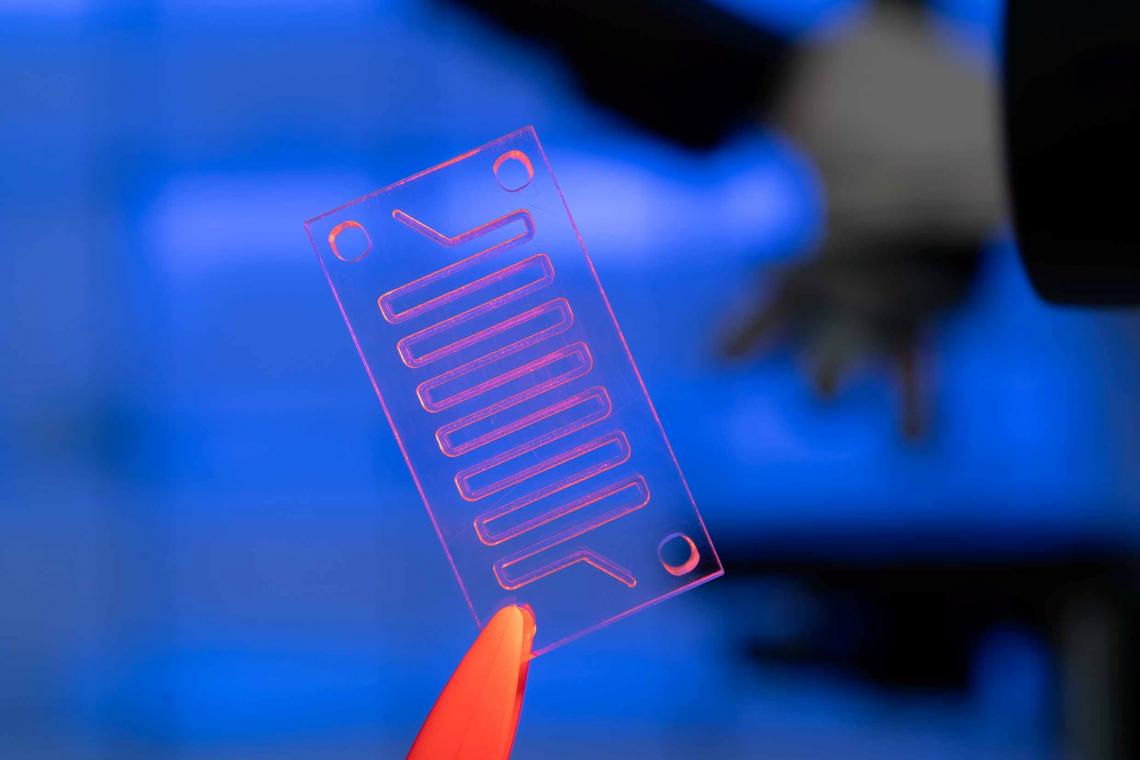Prof. CheolGi Kim(center) and his lab members
Lab-on-a-chip technology integrates one or more laboratory processes into a single miniaturized chip. It is possible to incorporate the proposed digital circuitry (pre-programmed magnetic patterns) into a single lab-on-chip in order to control and store the PsD holes
Researchers from Daegu Gyeongbuk Institute of Science and Technology have developed a digital circuitry for programmable manipulation and local storage of label-free matters. This approach supersedes existing cell manipulation methods and enables multiplex cell control, paving the way for a broad range of applications such as gene sequencing, disease diagnosis, and single-cell analysis.
The study of molecular and cellular processes has attracted particular attention in recent years owing to the deep insights it brings to the diagnosis and treatment of various diseases. Single-cell isolation and analysis are key processes for assessing cellular characteristics and dynamics within a cell population. Although there are several methods for single-cell analysis, magnetophoresis (the migration of particles in a magnetic field) offers significant advantages. However, existing magnetophoresis-based methods do not provide accurate and programmable manipulation of label-free single cells. They are also incapable of handling multiplex cell control for local storage.
In a recent study published in Nature Communications, a research team led by Prof. CheolGi Kim of Daegu Gyeongbuk Institute of Science and Technology (DGIST), Korea, developed a mattertronic circuitry control and multiplexed individual storage for single label-free cells. Describing the inspiration behind the study, Prof. Kim says, "Single-cell studies are crucial in diagnostics, drug response testing, and immunotherapy. Therefore, a manipulation technique that had less adverse effect on cells had to be developed.."
A mattertronic circuit is designed using general circuit theory to transport, switch, and store label-free cells, mimicking the functionality of electrical conductors, diodes, and capacitors. The researchers used a biocompatible ferrofluid medium with a substantially greater magnetization. As a result, the suspended non-magnetic particles and label-free cells exhibit strong diamagnetism. Non-magnetic particles and label-free cells are therefore referred to as "pseudo-diamagnetic (PsD) holes," akin to electronic holes.
To begin, the researchers adjusted the magnetization of ferrofluids to achieve desirable PsD hole transportation on the conductor. Consequently, the holes moved along linear negative micro-magnetic patterns. Next, they developed eclipse diode patterns for efficient switching of various PsD holes. Depending on the diode configuration, the eclipse diode patterns controlled and selectively switched these holes. Eclipse heights and junction gaps have an impact on the switching efficiency of PsD holes. The junction gaps and eclipse heights of 7 and 4 µm, respectively, offered the best combination for 100% switching efficiency.
Furthermore, the researchers designed capacitor patterns to store multiple PsD holes in one compartment as well as single PsD holes in individual compartments. The capacitor patterns prevent multiple PsD hole occupancies in a single compartment due to magnetic Coulomb-like interactions. Consequently, the individual PsD hole occupancy was found to be 96% accurate.
When the device was configured for parallel processing, the throughput improved significantly. Although the researchers concentrated on a specific region of the chip, dozens of similar microstructures may be installed in a single chip, further increasing the throughput. Prof. Kim excitedly concludes, "Using these automated magnetic patterns, it is possible to manipulate cells independently for each location, even within a single lab-on-a-chip! This novel platform for controlling label-free single cells sets the stage for more focused therapy, potentially reducing disease recurrence."
Reference
|
Authors: |
Sandhya Rani Goudu1,2, Hyeonseol Kim1, Xinghao Hu2, Byeonghwa Lim1, Kunwoo Kim1, Sri Ramulu Torati1, Hakan Ceylan2, Devin Sheehan2, Metin Sitti 2, CheolGi Kim1 |
|
Title of original paper: |
Mattertronics for programmable manipulation and multiplex storage of pseudo-diamagnetic holes and label-free cells |
|
Journal: |
Nature Communications |
|
DOI: |
|
|
Affiliations: |
1Department of Emerging Materials Science, DGIST, Daegu, Republic of Korea 2Physical Intelligence Department, Max Planck Institute for Intelligent Systems, Stuttgart, Germany |
*Corresponding author’s email: [email protected]
About Daegu Gyeongbuk Institute of Science and Technology (DGIST)
Daegu Gyeongbuk Institute of Science and Technology (DGIST) is a well-known and respected research institute located in Daegu, Republic of Korea. Established in 2004 by the Korean Government, the main aim of DGIST is to promote national science and technology, as well as to boost the local economy.
With a vision of “Changing the world through convergence", DGIST has undertaken a wide range of research in various fields of science and technology. DGIST has embraced a multidisciplinary approach to research and undertaken intensive studies in some of today's most vital fields. DGIST also has state-of-the-art-infrastructure to enable cutting-edge research in materials science, robotics, cognitive sciences, and communication engineering.
Website: https://www.dgist.ac.kr/en/html/sub01/010204.html
About the author
CheolGi Kim completed his Ph.D. from KAIST in Korea and his postdoctoral studies from NIST in the USA. He is currently a professor in the Department of Emerging Materials Science at DGIST. Moreover, he is the director of the Magnetics Initiative Life Care Research Center for Cardiovascular Disease Diagnosis. He specializes in magnetophoretic circuit technology that can control individual cells among several cell groups using magnetic devices. He also excels in bio-diagnosis technology, which employs micro-magnetic sensors. He is currently conducting several projects with government support and has published over 300 research articles in national and international scientific journals. Also, he has several domestic and international patents to his credit.



